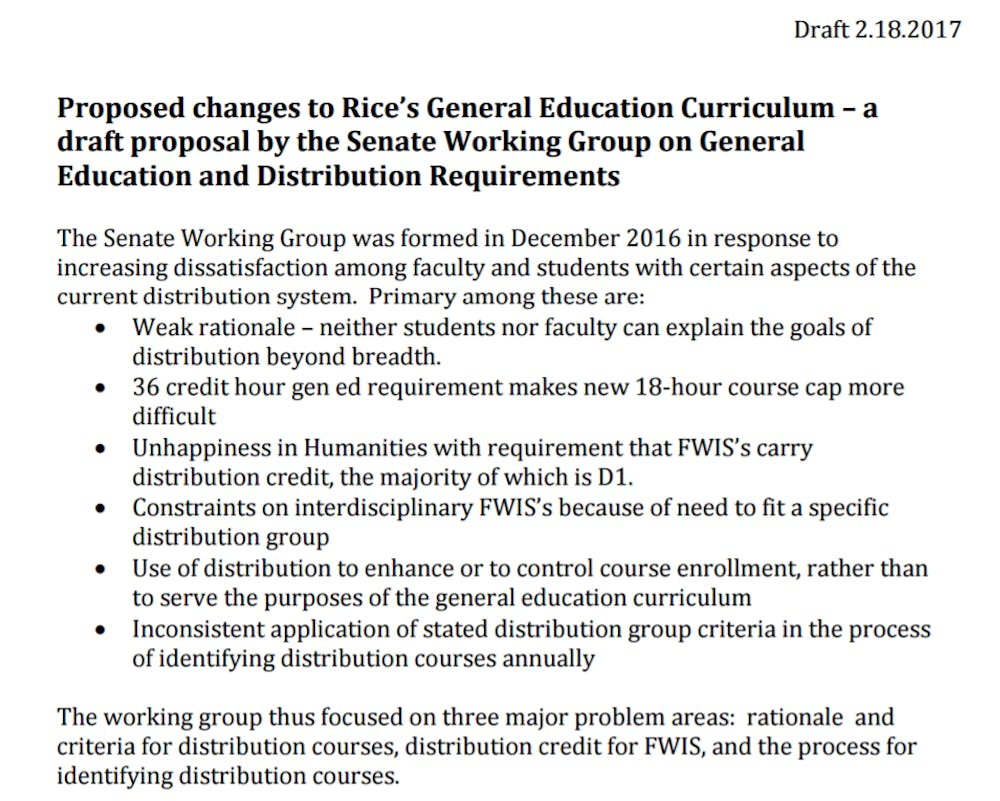Distribution requirements under scrutiny

The Faculty Senate Working Group on General Education and Distribution Requirements is proposing three major changes to the Distribution Requirements: reducing general education requirements from 36 credit hours to 30 hours, revising the language for each distribution group and placing the Course Review Committee from each of the six schools in charge of recommending courses for distribution credit.
According to the working group’s draft proposal, the group formed in December 2016 due to growing discontent among students and faculty with the current distribution system.
The proposal cites a lack of defined goals, difficulty meeting the 36 hour requirements under the new 18-hour credit cap, an inconsistency in identifying courses for distribution and professors utilizing the distribution classification to influence class sizes as issues with the current system as causes for discontent. In addition, the proposal states that the current requirement for First-Year Writing-Intensive Seminars to carry distribution credit has led to limits on interdisciplinary FWISes and dissatisfaction among humanities professors as a disproportionate amount of FWISes carry D1 credit.
Under the new proposal, the reduction to 30 hours would include nine hours in each distribution area in addition to the three-credit-hour FWIS. In the current system, students take 12 hours in each distribution area and FWIS carries distribution and fulfills part of the distribution requirements.
According to Rushi Bhalani, who represents the Student Association on the working group, the language revisions to the Purpose of the Distribution Requirements statement as well as the individual distribution requirement groups serve the purpose of making distribution courses both accessible to non-majors and broad based.
“[Accessibility] does not mean excluding upper-division courses,” Bhalani, a Baker College sophomore, said. “One of the leading maxims we use is: If this is the [only] course a student will take in this department, what would they get out of it?”
Currently distribution courses are identified by consensus among the deans, but the draft proposal states that in practice, courses are only identified within the individual schools. According to Bhalani, deans often approve the list of distribution courses from the previous year instead of evaluating additional courses, but the draft proposal addresses this by tasking the course review committee for each school with recommending distribution courses.
“Deans are not paying attention at the level that they should at the moment,” Bhalani said. “Every school has a school course review committee and they have agreed to take on the task of reviewing courses in the school. It’s a much more streamlined process where people inside each school have heard about which courses should and should not be distribution at a comprehensive level.”
More from The Rice Thresher

Rice welcomes 7.8% of applicants to class of 2029
Rice accepted 2,852 applicants to the class of 2029 March 26, said Yvonne Romero, vice president for enrollment. This represents 7.8% of 36,777, the highest acceptance rate since 2022.

Engineering school celebrates 50th anniversary, invites students, alumni and speakers
The George R. Brown School of Engineering invited engineering alumni, students and faculty to celebrate its 50th anniversary March 28-29. The event, which took place in the Engineering Quad, included speakers, a drone show, alumni gatherings and other social events like mixers.
Student store offers discounted merch to students
Select merchandise from the Campus Bookstore will now be available to students for a discounted price, according to an Instagram post by the Student Association in collaboration with the Campus Bookstore. Each month, designated “spirit items” will be offered at a 10% discount. For the month of March, the selected merchandise was two blue Rice T-shirts.


Please note All comments are eligible for publication by The Rice Thresher.